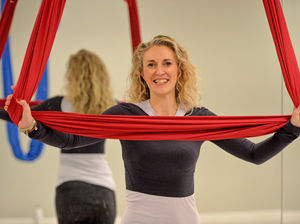Move your body and relax your mind with aerial yoga
Moving your body and relaxing your mind is the ultimate goal of yoga - but not every class requires you to get on a mat.

Aerial yoga where participants use a silk hammock that is suspended from the ceiling as a prop to support them to perform the different poses is becoming increasingly popular.
When Natalie Robertson first tried the practice, she was hooked and now she teaches classes at her studio, Rise Aerial Yoga, in Lichfield.
"I initially discovered aerial yoga in a moment of boredom watching videos on YouTube. It looked like fun, so I found a workshop in Manchester and went to try it out. From that first time in the hammock I decided that I was going to train to teach aerial yoga. The feeling of being in the hammock was incredible and I saw that using that hammock could have so many benefits for people and would be a great class to teach," she tells Weekend.

Mother of two Natalie trained to become a yoga teacher while she was working as a fitness instructor.
"I had practised yoga since my late teens, I wanted to be able to share the feelings that I got from my practice with others.
"The thing I love most is the feeling of being completely in the moment, it’s an escape from everything else that’s going on in the world around you. It’s like the only thing that exists is me, my body and my breath.
"And that I always, without fail feel better physically and mentally after having a bit of time on my mat, or in my hammock," she explains.
Aerial yoga first began in 1991 in New York when Broadway choreographer and former gymnast Christopher Harrison created anti-gravity workouts with a group of gymnastic athletes who wanted to continue to do aerial moves after they retired from competition.
"Aerial yoga is a yoga class, but we use a large aerial hammock to support us in the moves, the hammock is essentially a giant yoga prop," explains Natalie.
"Just like in mat practice we might use a block or a strap to help us in a pose, in aerial yoga we use the hammock.
"The benefits of aerial yoga are that the hammocks supports some our body weight, and allows us to get into poses that we don’t think we’ll be able to, especially inversions, that’s where we are upside down.
"In aerial yoga, inversions using the hammock allows us to completely hang upside down allowing a spine to decompress as its not subject to the pressures of gravity, this can relieve back, neck and shoulder pain.
"Many of my clients have found that their back complaints improve significantly through coming to classes.
"Aerial yoga is also great for improving flexibility and aiding in injury rehabilitation, the hammock supports the body allowing you to sink a little deeper into stretches. It’s also a low impact way of building strength, the hammock creates an element of instability which makes our bodies work hard, without subjecting them to a large amount of impact."
Although it may not look it, the practice is suitable for beginners and no prior knowledge of yoga is required.
"Anyone can do aerial yoga, you don’t need to have done any yoga before, or be super fit or flexible. The hammock supports you and helps you get into the poses, and there are different levels to all of the moves, they can be modified if necessary so everyone can participate in an aerial yoga class," explains Natalie, who also enjoys walking and paddleboarding in her spare time.

All of her classes are 'mixed level' so anyone can come along and join in the sessions. "There will sometimes be people in class who have been with me for five years and people that have just done a few classes.
"I keep the classes mixed level, because I want them to be inclusive - it is after all it is a yoga class and yoga is for everybody. "The classes are quite light hearted and fun, it’s definitely not a silent practice, it’s difficult to be quiet, or take yourself too seriously when you’re hanging upside down!
"There’s a sense of community on the classes as well, as people will often chat to each other and support and cheer each other on when they do a new move.
"We do however, always finish the class with savasana, where we lie in the hammocks and focus on our breath, and a short guided meditation, which is super relaxing, people often say that’s the best part of the class!," Natalie tells Weekend.
She enjoys getting to know her students and helping them to reap the benefits that practicing yoga can offer.
"There are so many things that I love about teaching yoga so it’s difficult to say what I enjoy the most! I enjoy sharing my passion and seeing the difference that it makes in other people’s lives, it’s wonderful to know that my clients see physical and mental benefits from their yoga practice. I also love connecting with people, they’re not just my clients, they’re part of my life, their part of my journey as a teacher and I’m part of theirs."
For more information, see facebook.com/Riseaerialyoga





